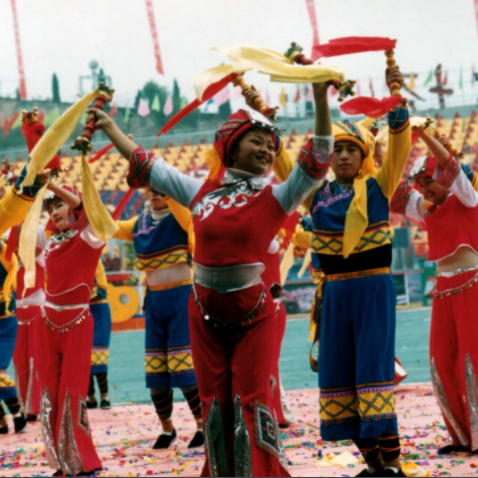babaotongling overview
 The Eight Treasures Copper Bell (pinyin: Bā bǎo tóng líng) is a bell handle made of a piece of hard wood that is one foot long and two centimeters in diameter. The fork is the horse's feet, and four copper bells the size of eggs are tied at each end (a total of eight copper bells). At one end of the horse's head, there are also five-color cloth strips (or hemp silk) five inches long and one inch wide. When performing, hold the bell handle and shake the copper bell according to the plot of the show, which is pleasant to the ear. The number of people performing the bronze bell dance is generally eight, but there are more than one or twenty people, but they all wear phoenix caps and eight Luo skirts (red, yellow, and blue three-colored eight cloth skirts, just like today's) folded skirt), performing activities on a flat ground (or a courtyard dam).
The Eight Treasures Copper Bell (pinyin: Bā bǎo tóng líng) is a bell handle made of a piece of hard wood that is one foot long and two centimeters in diameter. The fork is the horse's feet, and four copper bells the size of eggs are tied at each end (a total of eight copper bells). At one end of the horse's head, there are also five-color cloth strips (or hemp silk) five inches long and one inch wide. When performing, hold the bell handle and shake the copper bell according to the plot of the show, which is pleasant to the ear. The number of people performing the bronze bell dance is generally eight, but there are more than one or twenty people, but they all wear phoenix caps and eight Luo skirts (red, yellow, and blue three-colored eight cloth skirts, just like today's) folded skirt), performing activities on a flat ground (or a courtyard dam).A group of dancers wear phoenix crowns inlaid with beads and jade, wear eight colorful Luo skirts, and delicate copper bells hung with silk ribbons by hand. The singing is fierce and the dancing is rough. The Youyou Water in Xuanen, Hubei gave birth to the ancient Eight Treasures Bronze Bell Dance.
When playing, the left hand holds the middle wooden handle of the copper bell vertically and shakes it up and down. When sitting and playing, it can also hit the shoulders and knees. The sound is loud and clear. In the old days, it was used in ritual activities such as sacrificing and welcoming gods and sending ghosts hosted by Tujia shamans (also known as Tima and Tu Laosi). singing and dancing.
According to Luo Wenheng, director of the Culture and Sports Bureau of Xuan'en County, Hubei Province, the eight-treasure bronze bell dance, also known as "Jie Qian", is a traditional dance of the Tujia people and is the most popular in the Xuan'en area of Enshi. When the Tujia people worship their ancestors and pray for the harvest of grains and the prosperity of people and animals, they invite the Tu Laosi dance gods to "release money". In the minds of the Tujia people, the ancestors who have passed away are also "gods" who will always bless the future generations. Therefore, the Eight Treasures Bronze Bell Dance only has a festive and joyful atmosphere, and there is no gloomy and cold feeling in other sacrificial activities.
After the 1950s, the folk traditional "Eight Treasures Bronze Bell Dance" was introduced. The dancers held an Eight Treasures Bronze Bell in each hand and danced while playing. After the 1970s, Babao copper bells were used in instrumental ensembles such as the Tujia musical instrument dong dong quin, which is a rhythm instrument with national characteristics.
The Eight Treasures Copper Bell Dance regulates the rhythm of dance movements with crisp and pleasant bell rhythm, which has distinct national artistic characteristics. Eight Treasures Copper Bell Staff, about 40 cm long, with a horse's head carved on the top, a half-arc fork as a horse's foot on the bottom, and 4 horse bells at each end. The props are also musical instruments used for sacrificing dance conductors. When singing and dancing, Tu Laosi wears a three-parent 50-fold crown on his head, wears eight Luo skirts (eight cloth skirts in red, yellow, and blue, just like today's foldable skirts), and holds a sword and a sword. The dance is performed while singing the divine song, and the movements are rough and agile.
In addition to a small amount of the content of asking the gods to repay the wishes of the bronze bell dance, a large number of dance movements are a complete set of historical content narrating the ancient ancestors of the Tujia people on horseback hunting and migration, such as feeding horses, teasing horses, mounting, dismounting, and galloping horses. , horse racing and other movements, there are no less than fifteen or six kinds of dance postures only for ringing the bell. The dance is rough and emotional, and the number of people performing the copper bell dance is generally eight, as many as ten or twenty.
- Pinyin:Bā bǎo tóng líng
- geographical indication:Enshi, Hubei Province
- nationality:Tujia
- Classification:body music
reference materials and contributors
- 八宝铜铃 · 百度百科
- 八宝铜铃 · 搜狗百科
- 湖北恩施:铜铃叮当响 少儿传“非遗” · 新华网
overview of other similar instruments
- sanyanxiao overview
- Daguangxian overview
- Leiqin overview
- hahao overview
- yandundagu overview
- Han Xiaozheng overview
- Fang Xiang overview
- guanzi overview
- zhuqin (Dao Qin) overview
- zhuiqin overview
- bangzi overview
- three-stringed piano overview
- Gehu overview
- xiao overview
- xiaokonghou overview
- Konghou overview
- Sheng overview
- suona overview
- hulusi overview
- gushao overview
 渝公网安备 50010702504639号
渝公网安备 50010702504639号